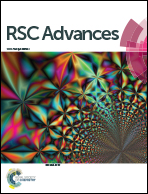Enhanced storage behavior of quasi-solid-state aluminum–selenium battery
Abstract
The current aluminum batteries with selenium positive electrodes have been suffering from dramatic capacity loss owing to the dissolution of Se2Cl2 products on the Se positive electrodes in the ionic liquid electrolyte. For addressing this critical issue and achieving better electrochemical performances of rechargeable aluminum–selenium batteries, here a gel-polymer electrolyte which has a stable and strongly integrated electrode/electrolyte interface was adopted. Quite intriguingly, such a gel-polymer electrolyte enables the solid-state aluminum–selenium battery to present a lower self-discharge and obvious discharging platforms. Meanwhile, the discharge capacity of the aluminum–selenium battery with a gel-polymer electrolyte is initially 386 mA h g−1 (267 mA h g−1 in ionic liquid electrolyte), which attenuates to 79 mA h g−1 (32 mA h g−1 in ionic liquid electrolyte) after 100 cycles at a current density of 200 mA g−1. The results suggest that the employment of a gel-polymer electrolyte can provide an effective route to improve the performance of aluminum–selenium batteries in the first few cycles.



 Please wait while we load your content...
Please wait while we load your content...